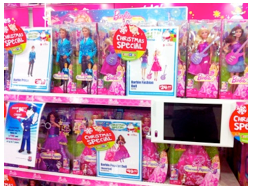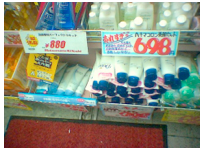My last post focused on poor in-store execution and how much it was costing the industry. But what about the activity that is activated exactly as planned? Even when things are executed perfectly, do activities always deliver the highest value to our brands? I’ve seen plenty of evidence that many well-executed in-store activities don’t deliver any return on investment, and I’ve also seen plenty of evidence that some in-store activities, done in the name of shopper marketing, can have a negative impact on long term brand value too.
Before the discussion of why this happens and what to do about it, let’s take a quick tour some recent in-store horrors I have witnessed.
 Olay – a brand to…. Kick in the face?
Olay – a brand to…. Kick in the face?
Here, on the staircase of an upmarket supermarket in Taiwan, even the mighty P&G makes mistakes. In an execution that probably looked great on the concept board, the Olay brand is scuffed and kicked by every passing shopper, looking a mess within days of installation. It may or may not have driven short term sales, but not what I’d want to do with a beauty brand if I were brand manager.

Barbie – you look… so cheap!
In Singapore Barbie is one of the more expensive dolls; yet here with laminated A4 sheets of paper announcing deals – concealing half of the product – you’d be hard pushed to tell. And where is this? In Toys R Us, the biggest toy retailer in Asia. (and as for executional excellence – the monitor isn’t working!)
 Dove – Real Beauty – Really?
Dove – Real Beauty – Really?
In the shadow of a billboard shouting out about a woman’s ‘real beauty’ I found this. Opening onto the sidewalk outside a chain drugstore in Tokyo, here is ‘real beauty’. In a wire basket, with a hand written discount card. And, I’m pretty sure, that the sales guys actually paid for this execution.
How do such terrible things happen to brands? Sometimes, short termism kicks in and there is a grab for short term sales. Sometimes the person who is executing this gets carried away and focuses solely on what the store will allow, without thinking about what it says about the brand. And sometimes the individual responsible for implementation is simply unaware of the impact of what they do on long term brand health. Yet these in-store executions often create far more impressions than our carefully crafted consumer communication.
Building brand equity may not be possible in every situation, but we can do our best to align, and make sure that execution doesn’t destroy hard (and expensively) won image. As in-store plans are developed, ask yourself these key questions:
How to stay true to your brand in-store
Does this support my brand equity (and do I even know what it is)? – What could be done to this execution that would make it more in line with the brand? It’s not always about building a brand in the store, but let’s make sure we’re at least supporting what we’re trying to say.
Does the brand have guidelines that must be adhered to? – In the Brand Diamond and Brand Pyramid Models which we use at engage to develop brands for clients, there is a clear statement of brand constraints: things the brand would never do, places the brand would never go. As you plan your activity, check that brand constraints are being honored. And if your brand model doesn’t describe brand constraints – perhaps it should!
How much of this is about what the retailer wants, and how much is about what is right for the brand? – Whilst we clearly need retail support, and alignment is a great, the retailer’s needs and constraints should not be the starting point. What is good for the brand should be the start; from there compromises can be charted, and blocked or mitigated where appropriate.
It’s not all about short term sales – We all know the pressure to hit the short term numbers; I’ve been there myself too often. But unless we can honestly say the impact of the activity on brand equity is at least neutral in the long term (it doesn’t have to be perfect), and that we’ve considered all practical alternatives, then we really aren’t trying hard enough.
Shoppers see our brands in stores every day. Poor compliance prevents our carefully crafted activities having the impact that they should. And a lack of strategic thought creates activities which needlessly damage our brands. Everything we do communicates. Everything sends a message. A brand manager who doesn’t take accountability for the entire brand is arguably not managing that brand. Her remit does not stop at the door to the store. More than ever there is a need for a Total Marketing solution, which ensures that brand guardianship covers everything we do. If you think your brand needs a Total Marketing approach, then drop me a line and let’s talk.




